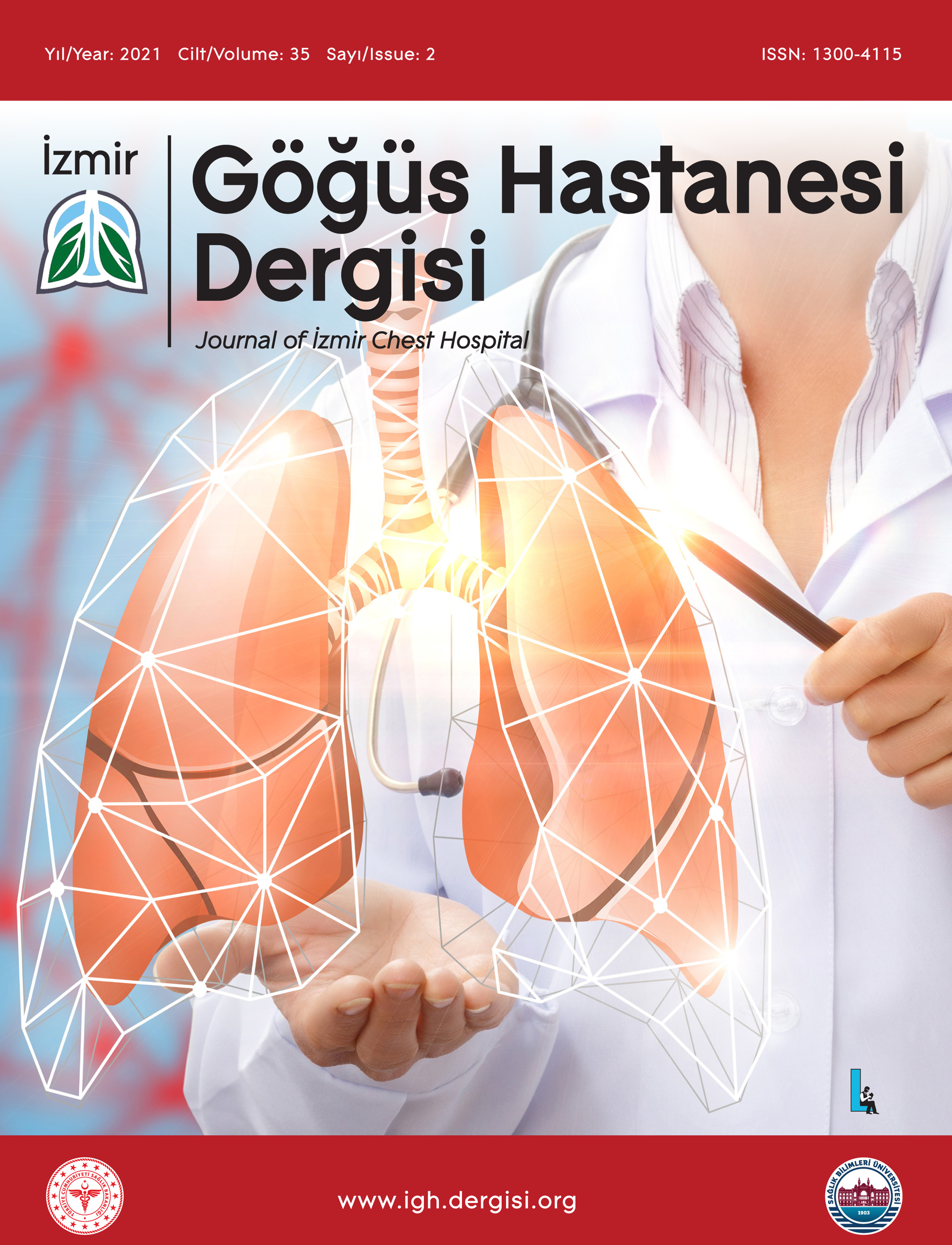KIRKDOKUZ PULMONER EMBOLİ OLGUSUNUN RETROSPEKTİF DEĞERLENDİRİLMESİ
Ahmet Emin ERBAYCU1, Fevziye TUKSAVUL1, Hayriye UÇAR1, Salih Zeki GÜÇLÜ1Göğüs Hastalıkları ve Cerrahisi Eğitim ve Araştırma Hastanesi, Göğüs Hastalıkları ve Tüberküloz Kliniği, İzmirPulmoner emboli (PE) pulmoner vasküler ağacın tümünün veya bir bölümünün çeşitli maddeler ile tıkanmasıdır. Pulmoner emboli tanısında spiral bilgisayarlı tomografisi (BT)'nin önemi giderek artmaktadır. Bu retrospektif çalışmada; PE tanılı olgulardan spiral toraks BT'si çekilmiş olan 49'unun klinik ve radyolojik özellikleri gözden geçirildi. En sık şikayetler nefes darlığı (%57.1) ve göğüs ağrısı (%55.1) idi. En sık fizik muayene bulgusu raller iken, olguların %41'inde muayene olağan idi. Olguların %24.5'i geçirilmiş derin ven trombozu (DVT) tarifliyor idi. Akciğer grafisinde en sık karşılaşılan bulgular infiltrasyon (%44.9) ve plevral sıvı (%24.5) idi. Pulmoner embolili 49 olgunun 39'unda spiral toraks BT ile trombüs saptandı (duyarlılık: %79.6). Trombüs en sık pulmoner arterin ilk dallanmasında (n=27, %69.2), daha sonra ana pulmoner arterde (n=15, %38.5) ve pulmoner arterin ikincil dallanmasında (n=2, %5.1) belirlendi. Bir (%2.6) olguda ventrikül içinde trombüs saptandı. Trombüs dışında spiral BT'de saptanan en sık bulgu plevral sıvı (%36.7) idi. Doppler ultrasonografisi ile olguların %29.6'sında alt ekstremite venlerinde derin ven trombozu saptandı. Sonuç olarak PE'li olgularda saptanan en sık bulgular; klinik olarak nefes darlığı, göğüs ağrısı; fizik muayenede raller; risk faktörü olarak DVT; akciğer grafisinde infiltrasyon ve plevral sıvıdır. Spiral toraks BT ile olguların önemli bir bölümünde pulmoner arter ve dallarında trombüs gösterilebilmektedir.
Anahtar Kelimeler: Pulmoner emboli, spiral toraks bilgisayarlı tomografisi, derin ven trombozuTHE RETROSPECTIVE EVALUATION OF FOURTYNINE CASES WITH PULMONARY EMBOLISM
Ahmet Emin ERBAYCU1, Fevziye TUKSAVUL1, Hayriye UÇAR1, Salih Zeki GÜÇLÜ1Göğüs Hastalıkları ve Cerrahisi Eğitim ve Araştırma Hastanesi, Göğüs Hastalıkları ve Tüberküloz Kliniği, İzmirPulmonary embolism (PE) is obstruction of the whole or some of the pulmonary vascular structure with various materials. The importance of spiral computed tomography (CT) on the diagnosis of PE is getting higher. In the retrospective study; of the cases with PE, clinical and radiological signs are evaluated in 49 those had spiral thorax CT. The mostly frequent complaints was breathlessness (57.1%) and chest pain (55.1%). The physical signs were normal in 41% where the mostly detected one was ral. It was detected that 24.5% of the patients had suffered deep vein thrombosis (DVT) before. The most common signs of chest radiography were infiltration (44.9%) and pleural effusion (24.5%). Thrombosis was detected by spiral thorax CT in 39 of 49 with PE (sensitivity: 79.6%). Thrombosis was detected mostly on the first branch of pulmonary artery (n=27, 69.2%), on the main pulmonary artery (n=15, 38.5%) and on the second branch of pulmonary artery (n=2, 5.1%). In one (2.6%) case thrombosis was in the ventricle. The mostly seen sign on spiral CT other than thrombosis was pleural effusion (36.7%). Deep vein thrombosis on lower extremity veins was found in 29.6% of the cases, using Doppler ultrasonography. In conclusion, the mostly frequent signs in PE are breathlessness, chest pain clinically; ral in physical exam; DVT as a risk factor; infiltration and pleural effusion on chest radiography. By using spiral thorax CT, it may be possible for a great part of cases to show thrombosis on pulmonary artery and its branches.
Keywords: Pulmonary embolism, spiral thorax computed tomography, deep vein thrombosisMakale Dili: Türkçe






